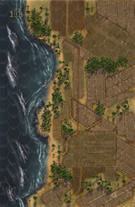| Author |
Schoenwulf
|
| Method |
Solo |
| Victor |
Japan |
| Play Date |
2020-04-04 |
| Language |
English |
| Scenario |
AArm002
|
Battle: After the Japanese landings on Guam in December, 1941, Japan established the South Seas Detachment to hold the island. However, the Guamanian Sergeant that had escaped from the Japanese landing assault mobilized a Guam Garrison and received assistance from the USA Hawaiin combined forces. The USA infantry troops were slightly hampered by dated equipment such as bolt-action Springfield rifles, but did include both mortar and tank platoons. This combined assault force moved east at noon and encountered Japanese resistance around 1330. By 1345 hours, Allied forces were assaulting the Japanese center, while both flanks continued to move west. The Guamanian/USA southern flank assaulted a Japanese infantry group at 1430 hours putting pressure on both the Japanese center and right. By 1545, all US armor had either been eliminated or broken down, but the Allied forces controlled the center and split the Japanese line around 1630. This left two Japanese fire groups on the flanks, and they took back control of their right flank shortly thereafter. As darkness fell, the Japanese left had held. Although the Allies had broken the Japanese line in the center, they were unable to drive the invaders from the island.Analysis: This 24-turn scenario demonstrates the “what-if” had the USA decided to strengthen the Guam garrison along the lines of the Hawaii one prior to the Japanese attack on Guam. Victory is solely driven by step loss. Since it is titled “Tanks of Guam”, one would think that the US armor would be of consequence; however, the combination of the tank breakdown special rule and the armor double step loss makes it difficult to utilize armor. This playthrough used a rather loose interpretation of the statement that there was “no additional penalty” when a tank breaks down other than a single step loss, so these breakdown step losses were not counted as double. Nonetheless, six steps were lost from the six tanks in play before they even reached combat. Exception was also taken to the 4th Edition rules on disorientation, as the scenario was played with the gentler approach used in the Saipan special rules. The best option might be to just count all tank steps as normal step losses instead of double, as this would give some balance. The extensive amount of jungle on the northern half of Map #83 makes an advance very time-consuming and disorganized, funneling the Allied front to the center and south portions of the map, with the slow tanks using the road until the first wreck blocks it. In the case of the Japanese units, they have a decided advantage in defensive setup in jungle and morale level that makes them very tough to overcome. Even with the house rulings, the Allied side suffered a solid defeat, losing 30 steps to the Japanese loss of 18.
|


 AArm001
AArm001 

























